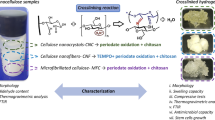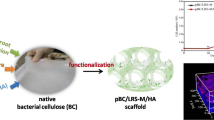Abstract
The extracellular matrix (ECM) is critical to cell attachment, proliferation, and differentiation; therefore, development of bioadaptive ECM-mimetic cell culture scaffolds is an active area of research in tissue engineering. Collagen (rigid nanofiber morphology) and hyaluronan (carboxy groups displayed in a regular manner) are typical ECM components found in vivo. In this work, we used wood-derived crystalline cellulose nanofibers (CNFs) to provide bioadaptive microenvironments for cell culture. Catalytic oxidation of wood CNFs using 2,2,6,6-tetramethylpiperidine 1-oxyl (TEMPO) afforded crystalline nanofibrous scaffolds with various carboxy contents, ranging from 0.31 to 1.60 mmol g–1, of the TEMPO-oxidized CNFs (TOCNFs). Mouse fibroblast cells were subjected to the hydrophilic TOCNF-coated substrates, which were transparent and exhibited a native cellulose I crystalline structure; good cell proliferation was observed for the TOCNFs with carboxy content of 0.8–1.0 mmol g–1, although intact CNF was bioinert and an excess of carboxylates negatively impacted cell growth. Neither mercerized TOCNFs with a cellulose II structure nor carboxymethylated CNFs with irregular surface carboxy groups contributed to cell proliferation. Therefore, the rigid nanofiber morphology of xeno-free, crystalline TOCNFs with regular alignment of surface carboxy groups would hold the key to providing bioadaptive, ECM-mimetic cellular microenvironments.
Graphic Abstract










Similar content being viewed by others
Data Availability
Data presented in this study are available in this article.
References
Arima Y, Iwata H (2007) Effect of wettability and surface functional groups on protein adsorption and cell adhesion using well-defined mixed self-assembled monolayers. Biomaterials 28:3074–3082. https://doi.org/10.1016/j.biomaterials.2007.03.013
Bian S, He M, Sui J et al (2016) The self-crosslinking smart hyaluronic acid hydrogels as injectable three-dimensional scaffolds for cells culture. Coll Surf B Biointerfaces 140:392–402. https://doi.org/10.1016/j.colsurfb.2016.01.008
Brown BN, Badylak SF (2014) Extracellular matrix as an inductive scaffold for functional tissue reconstruction. Transl Res 163:268–285
Chung C, Burdick JA (2009) Influence of three-dimensional hyaluronic acid microenvironments on mesenchymal stem cell chondrogenesis. Tissue Eng Part A 15:243–254. https://doi.org/10.1089/ten.tea.2008.0067
Clause KC, Barker TH (2013) Extracellular matrix signaling in morphogenesis and repair. Curr Opin Biotechnol 24:830–833
Courtenay JC, Johns MA, Galembeck F et al (2017) Surface modified cellulose scaffolds for tissue engineering. Cellulose 24:253–267. https://doi.org/10.1007/s10570-016-1111-y
De Souza Lima MM, Borsali R (2004) Rodlike cellulose microcrystals: structure, properties, and applications. Macromol Rapid Commun 25:771–787
Fishman JA, Scobie L, Takeuchi Y (2012) Xenotransplantation-associated infectious risk: a WHO consultation. Xenotransplantation 19:72–81. https://doi.org/10.1111/j.1399-3089.2012.00693.x
Frantz C, Stewart KM, Weaver VM (2010) The extracellular matrix at a glance. J Cell Sci 123:4195–4200
Fujisawa S, Okita Y, Fukuzumi H et al (2011) Preparation and characterization of TEMPO-oxidized cellulose nanofibril films with free carboxyl groups. Carbohydr Polym 84:579–583. https://doi.org/10.1016/j.carbpol.2010.12.029
Fukuzumi H, Fujisawa S, Saito T, Isogai A (2013) Selective permeation of hydrogen gas using cellulose nanofibril film. Biomacromol 14:1705–1709. https://doi.org/10.1021/bm400377e
Hakim RM (1993) Clinical implications of hemodialysis membrane biocompatibility. Kidney Int 44:484–494. https://doi.org/10.1038/ki.1993.272
Hatakeyama M, Nakada F, Ichinose H, Kitaoka T (2019a) Direct stimulation of cellular immune response via TLR2 signaling triggered by contact with hybrid glyco-biointerfaces composed of chitohexaose and cellohexaose. Coll Surf B Biointerfaces. https://doi.org/10.1016/j.colsurfb.2018.12.039
Hatakeyama M, Ryuno D, Yokota S et al (2019b) One-step synthesis of cellooligomer-conjugated gold nanoparticles in a water-in-oil emulsion system and their application in biological sensing. Coll Surf B Biointerfaces 178:74–79. https://doi.org/10.1016/j.colsurfb.2019.02.051
Heinze T, Pfeiffer K (1999) Studies on the synthesis and characterization of carboxymethylcellulose. Die Angew Makromol Chemie 266:37–45. https://doi.org/10.1002/(SICI)1522-9505(19990501)266:1%3c37::AID-APMC37%3e3.0.CO;2-Z
Hench LL (2002) Third-Generation biomedical materials. Science 295:1014–1017. https://doi.org/10.1126/science.1067404
Hirota M, Furihata K, Saito T et al (2010) Glucose/glucuronic acid alternating co-polysaccharides prepared from TEMPO-oxidized native celluloses by surface peeling. Angew Chemie Int Ed 49:7670–7672. https://doi.org/10.1002/anie.201003848
Hori R, Wada M (2005) The thermal expansion of wood cellulose crystals. Cellulose 12:479–484. https://doi.org/10.1007/s10570-005-5967-5
Hynes RO (2009) The extracellular matrix: not just pretty fibrils. Science 326:1216–1219
Isogai A, Saito T, Fukuzumi H (2011) TEMPO-Oxidized cellulose nanofibers. Nanoscale 3:71–85. https://doi.org/10.1039/C0NR00583E
Itoh H, Aso Y, Furuse M et al (2001) A Honeycomb collagen carrier for cell culture as a tissue engineering scaffold. Artif Organs 25:213–217. https://doi.org/10.1046/j.1525-1594.2001.025003213.x
Keselowsky BG, Collard DM, García AJ (2003) Surface chemistry modulates fibronectin conformation and directs integrin binding and specificity to control cell adhesion. J Biomed Mater Res A 66:247–259. https://doi.org/10.1002/jbm.a.10537
Kim HJ, Kim KK, Park IK et al (2012) Hybrid scaffolds composed of hyaluronic acid and collagen for cartilage regeneration. Tissue Eng Regen Med 9:57–62. https://doi.org/10.1007/s13770-012-0007-7
Kitaoka T, Yoshiyama C, Uemura F (2013) Hybrid immobilization of galactosyl lactose and cellobiose on a gold substrate to modulate biological responses. Carbohydr Polym 92:374–379. https://doi.org/10.1016/J.CARBPOL.2012.09.088
Klemm D, Heublein B, Fink H-P, Bohn A (2005) Cellulose: fascinating biopolymer and sustainable raw material. Angew Chemie Int Ed 44:3358–3393. https://doi.org/10.1002/anie.200460587
Kolpak FJ, Blackwell J (1976) Determination of the structure of cellulose II. Macromolecules 9:273–278. https://doi.org/10.1021/ma60050a019
Kondo T, Kose R, Naito H, Kasai W (2014) Aqueous counter collision using paired water jets as a novel means of preparing bio-nanofibers. Carbohydr Polym 112:284–290. https://doi.org/10.1016/j.carbpol.2014.05.064
Langer R, Vacanti JP (1993) Tissue engineering. Science 260:920–926. https://doi.org/10.1126/science.8493529
Lavoine N, Bergström L (2017) Nanocellulose-based foams and aerogels: processing, properties, and applications. J Mater Chem A 5:16105–16117
Law RC (2004) 5. Applications of cellulose acetate 5.1 cellulose acetate in textile application. Macromol Symp 208:255–266. https://doi.org/10.1002/masy.200450410
Liamas E, Kubiak-Ossowska K, Black RA et al (2018) Adsorption of fibronectin fragment on surfaces using fully atomistic molecular dynamics simulations. Int J Mol Sci 19:3321. https://doi.org/10.3390/ijms19113321
Lim YS, Ok YJ, Hwang SY et al (2019) Marine collagen as a promising biomaterial for biomedical applications. Mar Drugs 17:467
Lindroos B, Boucher S, Chase L et al (2009) Serum-free, xeno-free culture media maintain the proliferation rate and multipotentiality of adipose stem cells in vitro. Cytotherapy 11:958–972. https://doi.org/10.3109/14653240903233081
Ma J, Zhou Z, Gao M et al (2016) Biosynthesis of bioadaptive materials: A review on developing materials available for tissue adaptation. J Mater Sci Technol 32:810–814. https://doi.org/10.1016/j.jmst.2016.06.002
Maroudas NG (1975) Polymer exclusion, cell adhesion and membrane fusion. Nature 254:695–696. https://doi.org/10.1038/254695a0
Mazeau K (2011) On the external morphology of native cellulose microfibrils. Carbohydr Polym 84:524–532. https://doi.org/10.1016/j.carbpol.2010.12.016
Mazeau K, Wyszomirski M (2012) Modelling of Congo red adsorption on the hydrophobic surface of cellulose using molecular dynamics. Cellulose 19:1495–1506. https://doi.org/10.1007/s10570-012-9757-6
McLaughlin S (1977) Electrostatic potentials at membrane-solution interfaces. In: Current Topics in Membranes and Transport. pp 71–144
Meadows PY, Walker GC (2005) Force microscopy studies of fibronectin adsorption and subsequent cellular adhesion to substrates with well-defined surface chemistries. Langmuir 21:4096–4107. https://doi.org/10.1021/la047241v
Moon RJ, Martini A, Nairn J et al (2011) Cellulose nanomaterials review: structure, properties and nanocomposites. Chem Soc Rev 40:3941–3994. https://doi.org/10.1039/c0cs00108b
Nishino T, Matsuda I, Hirao K (2004) All-cellulose composite. Macromolecules 37:7683–7687. https://doi.org/10.1021/ma049300h
Nogi M, Iwamoto S, Nakagaito AN, Yano H (2009) Optically transparent nanofiber paper. Adv Mater 21:1595–1598. https://doi.org/10.1002/adma.200803174
Okita Y, Saito T, Isogai A (2010) Entire surface oxidation of various cellulose microfibrils by TEMPO-mediated oxidation. Biomacromol 11:1696–1700. https://doi.org/10.1021/bm100214b
Ostuni E, Yan L, Whitesides GM (1999) The interaction of proteins and cells with self-assembled monolayers of alkanethiolates on gold and silver. Coll Surf B Biointerfaces 15:3–30. https://doi.org/10.1016/S0927-7765(99)00004-1
Park S-N, Lee HJ, Lee KH, Suh H (2003) Biological characterization of EDC-crosslinked collagen–hyaluronic acid matrix in dermal tissue restoration. Biomaterials 24:1631–1641. https://doi.org/10.1016/S0142-9612(02)00550-1
Poosala P, Ichinose H, Kitaoka T (2016) Spatial geometries of self-assembled chitohexaose monolayers regulate myoblast fusion. Int J Mol Sci 17:686. https://doi.org/10.3390/ijms17050686
Poosala P, Kitaoka T (2016) Chitooligomer-immobilized biointerfaces with micropatterned geometries for unidirectional alignment of myoblast cells. Biomolecules 6:12. https://doi.org/10.3390/biom6010012
Rajala K, Hakala H, Panula S et al (2007) Testing of nine different xeno-free culture media for human embryonic stem cell cultures. Hum Reprod 22:1231–1238. https://doi.org/10.1093/humrep/del523
Ranaivoarimanana NJ, Habaki X, Uto T et al (2020) Nanocellulose enriches enantiomers in asymmetric aldol reactions. RSC Adv 10:37064–37071. https://doi.org/10.1039/d0ra07412h
Romberger DJ (1997) Fibronectin. Int J Biochem Cell Biol 29:939–943. https://doi.org/10.1016/S1357-2725(96)00172-0
Roshanbinfar K, Vogt L, Ruther F et al (2020) Nanofibrous composite with tailorable electrical and mechanical properties for cardiac tissue engineering. Adv Funct Mater 30:1908612. https://doi.org/10.1002/adfm.201908612
Saito T, Isogai A (2004) TEMPO-mediated oxidation of native cellulose. The effect of oxidation conditions on chemical and crystal structures of the water-insoluble fractions. Biomacromol 5:1983–1989. https://doi.org/10.1021/bm0497769
Saito T, Kuramae R, Wohlert J et al (2013) An ultrastrong nanofibrillar biomaterial: the strength of single cellulose nanofibrils revealed via sonication-induced fragmentation. Biomacromol 14:248–253. https://doi.org/10.1021/bm301674e
Saito T, Nishiyama Y, Putaux J-L et al (2006) Homogeneous suspensions of individualized microfibrils from TEMPO-catalyzed oxidation of native cellulose. Biomacromoelcules 7:1687–1691. https://doi.org/10.1021/bm060154s
Saito T, Uematsu T, Kimura S et al (2011) Self-aligned integration of native cellulose nanofibrils towards producing diverse bulk materials. Soft Matter 7:8804–8809. https://doi.org/10.1039/c1sm06050c
Schindelin J, Arganda-Carreras I, Frise E et al (2012) Fiji: an open-source platform for biological-image analysis. Nat Methods 9:676–682. https://doi.org/10.1038/nmeth.2019
Sekiguchi R, Yamada KM (2018) Basement membranes in development and disease. Curr Top Dev Biol 2018(03/31):143–191
Stipanovic AJ, Sarko A (1976) Packing analysis of carbohydrates and polysaccharides. 6. Molecular and crystal structure of regenerated cellulose II. Macromolecules 9:851–857. https://doi.org/10.1021/ma60053a027
Suzuki D, Takahashi M, Abe M et al (2008) Comparison of various mixtures of β-chitin and chitosan as a scaffold for three-dimensional culture of rabbit chondrocytes. J Mater Sci Mater Med 19:1307–1315. https://doi.org/10.1007/s10856-007-3245-9
Tamura Y, Kanomata K, Kitaoka T (2018) Interfacial hydrolysis of acetals on protonated TEMPO-oxidized cellulose nanofibers. Sci Rep 8:5021. https://doi.org/10.1038/s41598-018-23381-8
Theocharis AD, Skandalis SS, Gialeli C, Karamanos NK (2016) Extracellular matrix structure. Adv Drug Deliv Rev 97:4–27
Uetani K, Koga H, Nogi M (2019) Estimation of the intrinsic birefringence of cellulose using bacterial cellulose nanofiber films. ACS Macro Lett 8:250–254. https://doi.org/10.1021/acsmacrolett.9b00024
Uetani K, Ranaivoarimanana NJ, Hatakeyama M, Kitaoka T (2021) Inherently distinctive potentialities and uses of nanocellulose based on its nanoarchitecture. BioResources 16:4438–4473. https://doi.org/10.15376/biores.16.2.4438-4473
Wilson CJ, Clegg RE, Leavesley DI, Pearcy MJ (2005) Mediation of biomaterial–cell interactions by adsorbed proteins: a review. Tissue Eng 11:1–18. https://doi.org/10.1089/ten.2005.11.1
Wågberg L, Decher G, Norgren M et al (2008) The build-up of polyelectrolyte multilayers of microfibrillated cellulose and cationic polyelectrolytes. Langmuir 24:784–795. https://doi.org/10.1021/la702481v
Yoshiike Y, Kitaoka T (2011) Tailoring hybrid glyco-nanolayers composed of chitohexaose and cellohexaose for cell culture applications. J Mater Chem 21:11150–11158. https://doi.org/10.1039/C1JM11448D
Zahari NK, Idrus RBH, Chowdhury SR (2017) Laminin-coated poly(methyl methacrylate) (PMMA) nanofiber scaffold facilitates the enrichment of skeletal muscle myoblast population. Int J Mol Sci 18:2242. https://doi.org/10.3390/ijms18112242
Zhao J, Diaz-Dussan D, Wu M et al (2021) Dual-cross-linked network hydrogels with multiresponsive, self-healing, and shear strengthening properties. Biomacromol 22:800–810. https://doi.org/10.1021/acs.biomac.0c01548
Acknowledgments
The authors appreciate technical assistance from the Center of Advanced Instrumental Analysis, Kyushu University; and the Ultramicroscopy Research Center, Kyushu University. The authors are grateful to Ms. Kana Ichibakase for technical support regarding cell assays.
Funding
This research was funded by the Grant-in-Aid for Scientific Research (KAKENHI) Program (grant numbers JP20K22592 to M.H., JP21K14890 to M.H., JP17H01482 to T.K. and JP18K19233 to T.K.) from the Japan Society for the Promotion of Science, and the Short-term Intensive Research Support Program from the Faculty of Agriculture, Kyushu University (M.H. and T.K.).
Author information
Authors and Affiliations
Contributions
M.H. and T.K. conceived the conception of this work. M.H. conducted all experiments and analytical characterization. T.K. designed research as a project administrator. M.H. and T.K. contributed to writing and reviewing the manuscript. Both authors have read and approved the published version of the manuscript.
Corresponding author
Ethics declarations
Conflicts of interest
The authors declare no conflict of interest.
Additional information
Publisher's Note
Springer Nature remains neutral with regard to jurisdictional claims in published maps and institutional affiliations.
Supplementary Information
Below is the link to the electronic supplementary material.
Rights and permissions
About this article
Cite this article
Hatakeyama, M., Kitaoka, T. Surface-Carboxylated Nanocellulose-Based Bioadaptive Scaffolds for Cell Culture. Cellulose 29, 2869–2883 (2022). https://doi.org/10.1007/s10570-021-04154-5
Received:
Accepted:
Published:
Issue Date:
DOI: https://doi.org/10.1007/s10570-021-04154-5




